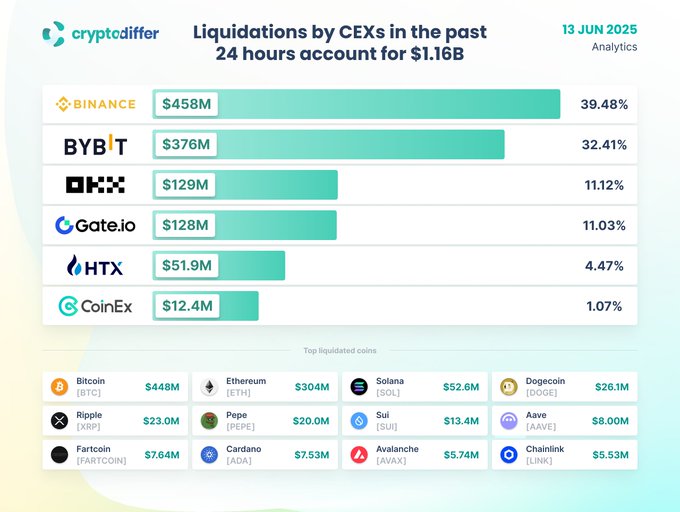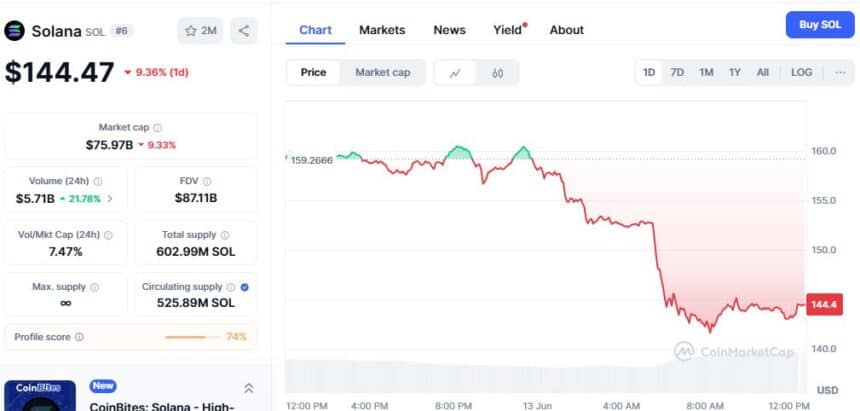Crypto liquidations soared to $1.16 billion across centralized exchanges (CEXs) in just 24 hours, triggered by geopolitical tensions. The immediate cause was the Israeli military strike on Iran, which caused widespread panic in global markets.
Bitcoin’s price plunged, and the shockwaves were felt across the entire cryptocurrency market. Within hours, crypto liquidations exploded as traders scrambled to minimize losses.

Bitcoin Liquidations Soar
Bitcoin was the hardest-hit asset, with a staggering $448 million worth of BTC positions liquidated. The price of Bitcoin plummeted below $104,000, setting off a chain reaction across other digital currencies. Altcoins, including Ethereum, Solana, and Dogecoin, were not spared. The massive sell-off wiped out millions of dollars in crypto assets, leading to a market rout.
Ethereum, the second-largest cryptocurrency by market cap, also faced significant losses, with $304 million worth of ETH positions liquidated. The rapid decline in Bitcoin’s price triggered a broader downturn in the market, and Ethereum, along with other altcoins, followed suit.
Ethereum and Other Altcoins Hit Hard
Ethereum was second in line, with $304 million worth of ETH positions liquidated. Ethereum’s price drop mirrored Bitcoin’s, contributing to the overall liquidations across exchanges. Solana, Dogecoin, and Sui also took substantial hits during the crash, with Solana seeing $52.6 million in liquidations.
Dogecoin, a memecoin that has gained significant attention in recent months, was also affected. The popular altcoin saw a 9.20% drop in its price, resulting in $26.1 million worth of liquidations. Traders who held long positions in Dogecoin took the brunt of the losses, highlighting the risks involved with investing in volatile cryptocurrencies.
Solana’s Steep Fall
Solana was one of the biggest casualties, losing over 9% of its value. The cryptocurrency fell to $144.47, causing $52.6 million in liquidations. Of these crypto liquidations, $46.14 million were from long positions, where traders bet on Solana’s price rising.
The crash marked a major setback for Solana, which had seen some positive price movement before the market turmoil hit. Solana’s vulnerability, due to its relatively thin order books, made it especially susceptible to the rapid sell-off.

Sui and Litecoin: Smaller But Significant Losses
Sui was another altcoin that took a sharp hit, dropping nearly 11% in value. The price dropped to $3, and over $13.4 million in positions were liquidated. Of that, $12.6 million were long positions. The sharp drop in Sui’s price, combined with its thin market depth, made it one of the biggest percentage losers during the market crash.
Litecoin, typically known for its stability, was also dragged into the turmoil. Litecoin fell by 7%, resulting in $4.13 million in liquidations. The majority of the liquidations in Litecoin were from long positions, which accounted for $4.04 million.
Crypto Liquidations by Exchange
Binance and Bybit played a major role in the $1.16 billion crypto liquidations. Binance alone accounted for $458 million, or 39.48% of the total. Bybit followed closely with $376 million, making up 32.41% of the liquidations.
Together, these two exchanges were responsible for over 70% of all liquidations in the 24-hour period, underscoring their significant impact on the cryptocurrency market. Other exchanges like OKX, Gate.io, HTX, and CoinEx also reported significant crypto liquidations, with OKX and Gate.io contributing $129 million and $128 million, respectively.
Market Response and Trading Surge
As the crypto market experienced this massive surge in crypto liquidations, trading volume spiked to $1.87 billion. Retail traders, who are typically seen as the backbone of the crypto market, found themselves on the other side of the trade, forced to sell their assets to limit their losses.
Sui and Litecoin saw substantial trading volume increases, with Sui’s trading volume up by 79% and Litecoin’s up by 14.07%. The broader market’s volume jump indicated that the sell-off was widespread, affecting both large and small players in the crypto market.
Conclusion
The $1.16 billion in crypto liquidations highlights the inherent volatility of the cryptocurrency market. Geopolitical events like the Israeli military attack on Iran can have a dramatic impact on digital assets, triggering mass liquidations. Binance and Bybit’s dominance in the liquidation process further showcases their massive influence on the market.
As the crypto market grows, it is evident that external shocks can significantly affect the market’s stability. Traders and investors must be prepared for sudden changes and consider risk management strategies to minimize losses in volatile market conditions.
Frequently Asked Questions (FAQ)
1. What caused the crypto liquidation surge?
Geopolitical tensions, particularly the Israeli military strike on Iran, caused Bitcoin’s price to plummet, triggering widespread crypto liquidations across crypto markets.
2. Which cryptocurrencies were most affected?
Bitcoin, Ethereum, Solana, Dogecoin, and Sui were among the most affected by the liquidations, with Bitcoin suffering the largest losses.
3. Which exchanges saw the most liquidations?
Binance and Bybit accounted for more than 71% of all crypto liquidations, with Binance contributing $458 million and Bybit $376 million.
4. How did the market react to these liquidations?
The market saw a sharp rise in trading volume, with $1.87 billion traded as investors rushed to minimize losses during the market downturn.
Appendix: Glossary of Key Terms
Crypto Liquidations: The forced closure of a trader’s leveraged position when the market moves against them, often due to a price drop.
Centralized Exchange (CEX): A platform where cryptocurrencies are traded, and transactions are managed by a centralized authority.
Bitcoin (BTC): The first and most well-known cryptocurrency, created in 2009 by an anonymous individual or group known as Satoshi Nakamoto.
Ethereum (ETH): A decentralized platform that enables the creation of smart contracts and decentralized applications (dApps) through its blockchain.
Altcoins: Any cryptocurrency other than Bitcoin, including Ethereum, Solana, and Dogecoin, often used to refer to smaller or alternative digital assets.
Long Position: A trading strategy where the investor buys an asset with the expectation that its price will rise.
Market Cap: The total value of a cryptocurrency, calculated by multiplying its current price by the total supply of coins.
Reference
Crypto Time – cryptotimes.io













































































































